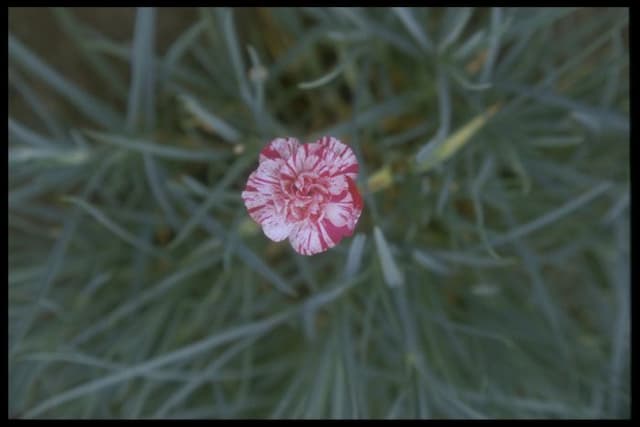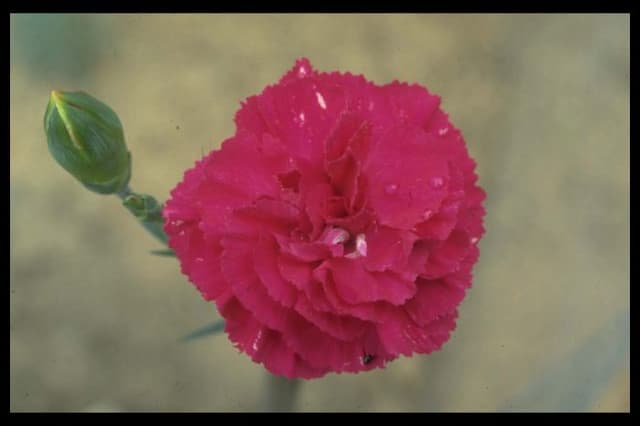Cheddar Pink Dianthus gratianopolitanus

ABOUT
Commonly known as Cheddar Pink, this plant is a perennial with a mat-forming habit. It boasts slender, gray-green leaves that are linear and opposite, creating a dense, tufted mound. The foliage often has a blue-green or silver-green color, giving it a distinctive appearance. During the blooming period, Cheddar Pink is adorned with a profusion of small, vibrant pink flowers. These blooms are notable for their frilled petal edges and the rich, spicy fragrance they emit, reminiscent of cloves. The flowers typically have five petals, each with a slightly jagged margin, and often display a central eye of a contrasting hue. These blossoms are held atop thin, erect stems that rise above the foliage and cluster together, forming a striking display. The vivid colors of Cheddar Pink, combined with its attractive foliage and pleasant scent, make it a popular choice for rock gardens, borders, and as a ground cover in landscaping.
About this plant
 Names
NamesFamily
Caryophyllaceae
Synonyms
Cheddar Pink, Fragrant Pink, Clove Pink, Cheddar Pinks, Firewitch, Caesius Pink, Sweet Pink, Garden Pink
Common names
Dianthus caesius, Dianthus sylvestris, Dianthus versicolor, Dianthus sudeticus, Dianthus tergestinus.
 Toxicity
ToxicityTo humans
Cheddar Pinks are not known to be toxic to humans. In general, they do not cause significant adverse effects if touched or ingested in small quantities. However, as with any plant, individual allergic reactions or irritations can occur so it is always advisable to handle plants cautiously if you are not familiar with them.
To pets
Cheddar Pinks are not considered toxic to pets either. They are generally safe for cats and dogs, and there are no well-documented reports of poisoning in pets from ingesting this plant. However, each animal can react differently to various plants, and some might experience mild digestive discomfort if they consume significant amounts. It's always a good idea to discourage pets from eating non-food plants as a precaution.
 Characteristics
CharacteristicsLife cycle
Perennials
Foliage type
Evergreen
Color of leaves
Blue-green
Flower color
Pink
Height
6-12 inches (15-30 cm)
Spread
6-12 inches (15-30 cm)
Plant type
Herb
Hardiness zones
3-9
Native area
Europe
Benefits
 General Benefits
General Benefits- Aesthetic Appeal: Dianthus gratianopolitanus, commonly known as cheddar pink, offers vibrant pink to light purple flowers, adding color and visual interest to gardens.
- Long Blooming Season: With a blooming season extending from late spring to early summer, it ensures a long period of floral display.
- Drought Tolerance: Once established, cheddar pink is tolerant of dry conditions, making it suitable for xeriscaping or low-water gardens.
- Ground Cover: This plant forms a mat-like growth, providing excellent ground cover and helping to reduce weed growth.
- Fragrance: Its flowers emit a spicy, clove-like fragrance, which can be delightful in garden settings or when used as cut flowers indoors.
- Attracts Pollinators: The flowers of cheddar pink attract butterflies and bees, supporting local ecosystems.
- Low Maintenance: It generally requires minimal care, making it a good choice for gardeners seeking low-maintenance plants.
- Edging Plant: Due to its compact size and dense growth habit, it is ideal for use as edging along paths or garden borders.
- Cold Hardy: Cheddar pink is capable of withstanding cold temperatures, making it suitable for many temperate climates.
- Versatility: The plant can be used in rock gardens, containers, and as part of mixed perennial beds, offering versatility in garden design.
 Medical Properties
Medical Properties- There is no widespread evidence of Dianthus gratianopolitanus, also known as Cheddar pink, being used for medical purposes.
 Air-purifying Qualities
Air-purifying QualitiesThis plant is not specifically known for air purifying qualities.
 Other Uses
Other Uses- Decorative dried flowers: Cheddar pink petals can retain their color when dried, making them suitable for use in dried floral arrangements and potpourri.
- Edible flowers: The blooms of Cheddar pink are edible and can be used to add a spicy, clove-like flavor to dishes, as well as being a colorful garnish in salads and desserts.
- Essential oils: Though not the primary source, Cheddar pink can be used to distill essential oils for use in homemade perfumes and scented candles, contributing a subtle fragrance.
- Natural dye: The flowers can be used to create natural dyes for fabrics or art projects, producing a range of pink hues depending on the mordant used.
- Garden borders: Cheddar pink makes an attractive and colorful edge for walkways and garden borders, as its dense mat-forming habit provides a clear demarcation.
- Symbolic gifts: In the language of flowers, Dianthus signifies boldness and pure affection, making Cheddar pink a meaningful gift for someone special.
- Lucky charm: In some cultures, it is believed that carrying a bloom of Cheddar pink can bring good fortune and ward off negativity.
- Companion planting: Cheddar pink can be used in companion planting to attract pollinators, benefitting the surrounding plants in the garden.
- Butterfly gardens: The flowers are known to attract butterflies, making them a good choice for butterfly gardens or wildlife-friendly landscapes.
- Culinary decoration: Petals of Cheddar pink can be crystallized with egg white and sugar to create elegant decorations for cakes and pastries.
Interesting Facts
 Feng Shui
Feng ShuiThe Cheddar Pink is not used in Feng Shui practice.
 Zodiac Sign Compitability
Zodiac Sign CompitabilityThe Cheddar Pink is not used in astrology practice.
 Plant Symbolism
Plant Symbolism- Love: Dianthus gratianopolitanus, commonly known as Cheddar pink, is often associated with love and affection, reflecting the typical association of flowers with romantic feelings.
- Passion: The bright and bold colors of Cheddar pink can symbolize deep passion and a vivacious spirit, akin to the fervor of new love or intense admiration.
- Admiration: Cheddar pink can represent admiration and may be given as a gift to someone whom the giver holds in high regard.
- Pure Affection: Sometimes these flowers are connected to a more innocent form of affection, not strictly limited to romantic love but encompassing a broader, platonic appreciation.
- Boldness: The vivid hues and spicy fragrance of the Cheddar pink suggest a symbol of boldness and daring, potentially reflecting the character of a person or the nature of a relationship.
- Longevity: Due to their hardy nature and perennial growth, Cheddar pinks are sometimes symbolic of enduring commitment and the lasting nature of an endeavor or relationship.
 Water
WaterThe common name for Dianthus gratianopolitanus is 'Cheddar Pink'. Watering Cheddar Pink deeply is recommended to promote a strong root system, with the watering frequency depending on the weather and soil moisture levels, typically once weekly. It prefers well-draining soil, so it's important to allow the soil to dry out slightly between waterings. When watering, apply approximately one gallon of water per square foot of soil, ensuring even soil moisture without waterlogging. During periods of drought or extreme heat, you may need to water more frequently, but always check the soil before adding water to prevent over-watering.
 Light
LightCheddar Pink thrives best in full sunlight conditions. This plant should be situated in a spot where it can receive at least six hours of direct sunlight daily. Avoid placing Cheddar Pink in shaded areas, as insufficient light can hinder flowering and overall plant vitality.
 Temperature
TemperatureCheddar Pink is quite hardy and can tolerate a range of temperatures, though it flourishes in cooler conditions. It can withstand temperatures down to about 20 degrees Fahrenheit but prefers climates where the temperature stays above freezing. The ideal temperature range for Cheddar Pink growth is between 60 and 70 degrees Fahrenheit during the day.
 Pruning
PruningCheddar Pink should be pruned to remove dead flowers, which encourages further blooming and prevents self-seeding if not desired. Best time for pruning Cheddar Pink is after the main bloom in late spring or early summer. It can also be lightly trimmed back in the fall to maintain a compact growth habit.
 Cleaning
CleaningAs needed
 Soil
SoilCheddar Pinks flourish in well-draining soil with a neutral to slightly alkaline pH of 6.5 to 7.5. A winning mix might include equal parts garden soil, compost, and sharp sand or perlite to ensure good drainage. Regular testing and amending with lime can help maintain an appropriate pH level.
 Repotting
RepottingCheddar Pinks should be repotted every two to three years to refresh the soil and accommodate root growth. A sign that repotting is needed is roots crowding the pot or growing through the drainage holes.
 Humidity & Misting
Humidity & MistingCheddar Pinks prefer low to moderate humidity levels. Excessively high humidity can lead to fungal issues. They thrive in open, ventilated areas where air flow is sufficient to keep moisture levels balanced.
 Suitable locations
Suitable locationsIndoor
Place Cheddar Pinks in a sunny window, keep soil lightly moist.
Outdoor
Plant in a sunny spot with good drainage and space for air flow.
Hardiness zone
3-9 USDA
 Life cycle
Life cycleDianthus gratianopolitanus, more commonly known as the Cheddar Pink, begins its life cycle when seeds germinate in late spring, provided they're in a well-drained, slightly alkaline soil with full sun exposure. Following germination, it enters a vegetative stage where foliage grows and establishes a strong root system. This perennial then progresses to the flowering stage, typically in late spring to early summer, producing fragrant pink to purplish flowers which attract a variety of pollinators. After pollination, the plant sets seed, which can either fall near the parent plant or be dispersed by wind. Over winter, the Cheddar Pink enters a period of dormancy, conserving energy and resources; in regions with milder climates, it may retain its foliage year-round. With the arrival of favorable conditions in the subsequent growing season, the cycle continues with new growth from the crown, completing the perennial cycle of the Cheddar Pink.
 Propogation
PropogationPropogation time
Spring to early summer
Cheddar Pinks, commonly known as Dianthus gratianopolitanus, can be propagated through different methods, but the most popular technique is using stem cuttings. To do so, cuttings should be taken in late spring or early summer from non-flowering stems. Each cutting should be about 4 to 6 inches (10 to 15 centimeters) long. The lower leaves should be removed and the cut end dipped in rooting hormone powder before being placed in a mixture of peat and perlite. These cuttings need to be kept in a warm, bright spot but out of direct sunlight, making sure to maintain the humidity until roots have developed, which usually takes a few weeks. Once rooted, the new plants can be transplanted into individual pots or directly into the garden.




![Pink [Coconut Sundae]](/_next/image?url=https%3A%2F%2Fplants-admin.emdemapps.com%2Fimages%2Fplants%2F%2Fimages%2F604b5d09d4fd1.png&w=640&q=75)




